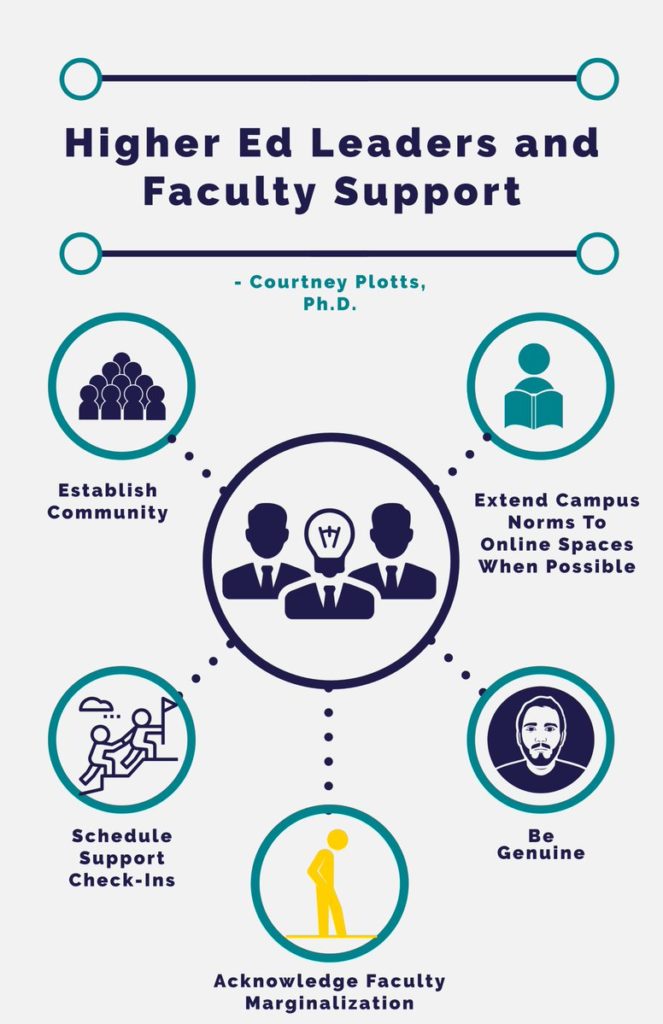It’s nearly ten months into a global pandemic and higher education faculty are understandably overwhelmed. Seventy-six percent of higher ed staff say their workplace stress has increased since the onset of COVID-19.1 Of this number, 43 percent say their stress stems from an increased workload. The ultimate question is: how do you meet the needs of all students, without burning yourself out? We asked nine expert educators from our #ProfChats panel for their techniques on delivering impactful learning experiences without sacrificing mental wellbeing. Here’s what they had to say.
Top Hat’s 2021 Online Teaching Toolkit gives you everything you need to save time in course prep and delivery. Get free access today.
1. Think outside the box when it comes to student engagement
Variety is the spice of life. Mix up lectures with opportunities for group work and even guest lectures. Small changes add up, suggests Jasmine Roberts, a strategic communication lecturer in the School of Communication at The Ohio State University.
A1: I am still trying to figure this out myself. A few things that have helped with streamlining course prep: Build in activities for small group discussion. Utilize guest speakers. Sometimes students get tired of just hearing from us 😉#ProfChats
— Jasmine Roberts (@ProfJasmine) January 21, 2021

Will students benefit from a particular assignment or reading? Your department colleagues can help you make that call, so says Courtney Plotts, National Chair of the Council for At-Risk Student Education and Professional Standards.
Not all elements of face-to-face learning can—or should—be translated to your virtual classroom. Jennifer Honeycutt, Assistant Professor of Psychology and Neuroscience at Bowdoin College, suggests taking a close look at your learning objectives and planning both independent and group activities around them.
If doing things the same as normal, but translating it to an online platform (extra recorded lectures), ends up being a burden, try and think of alternatives. Consider the learning goals – by what other means can the students obtain these learning outcomes?#ProfChats 3/5
— Dr. Jennifer Honeycutt 🏳️🌈🧠👩🏼🔬 (@ohambiguity) January 21, 2021
2. It’s okay to prioritize mental health
While course readings and assignments will solidify concepts, your empathy towards students will ultimately make the difference in today’s learning environment. Jasmine Roberts underscores the importance of student wellbeing.
A3: We are teaching STUDENTS, not content.
We need to keep students wellness in mind first and foremost.
They will remember that more about your class and who you are as a professor rather than the content you covered. #ProfChats
— Jasmine Roberts (@ProfJasmine) January 21, 2021
The classroom won’t be an enjoyable space to teach or learn if both you and your students are overworked. Lee Skallerup Bessette, Learning Design Specialist at CNDLS, suggests letting go from time to time.
A1: Let go a little. As my colleague said recently, “if you and your students are so burned out they can’t learn, are you really covering the learning materials” #ProfChats
— Dr. Lee Skallerup Bessette (@readywriting) January 21, 2021
Give your students a leg up. Paula Patch, Senior Lecturer in English and Assistant Director for First-Year Initiatives at Elon University, suggests building in enough time to help students get through activities during class—versus on their own.
A3: Suspect profs overestimate how much “work” students actually perform in class. While we are working and engaging the entire time—and we create content for that—students are interacting with that content for only a few minutes out of that time. #ProfChats https://t.co/yXiKoVXpto
— Paula Patch (@profpatch) January 21, 2021
Get student feedback to ensure your teaching practices are relevant and impactful. Tazin Daniels, Assistant Director at the Center for Research on Learning and Teaching at the University of Michigan, shares a solution you can easily implement in your course.
A3. An experience of “workload” is relative to so many factors, including the emotional, cognitive and emotional resources available to students, which we know is unbearably depleted right now. I think the key is to get regular feedback and adjust accordingly. #ProfChats pic.twitter.com/jMtl3qqvI0
— Dr. Tazin Daniels (@ThePedagologist) January 21, 2021
Balancing a mixture of synchronous and asynchronous delivery in your course, plus blocking time for yourself during the week, can help prevent burnout. Thomas Tobin, Program Area Director for Distance Teaching & Learning at the University of Wisconsin-Madison, shares an article by Flower Darby focused on maintaining a healthy work-life balance.
#ProfChats A6. @Flowerdarby recently shared in the @chronicle about avoiding burnout (https://t.co/FFekb6XBR6).
Plus, campus leaders should 1) define clear teaching expectations, 2) train support staff in #UDL, & 3) do #FacDev for *all* instructors.https://t.co/M63nzqpE5F
— Thomas J. Tobin (@ThomasJTobin) January 21, 2021
3. Seek out support from your institution
Support systems in higher ed often trickle down. Seek out resources from your faculty leaders, which you can then pass onto students, suggests Jennifer Honeycutt.
A6: Institutions should make sure to provide faculty with updated information re: student resources (health, counseling, etc) and what is changed due to COVID (and protocols!) so that we have the most up-to-date info and can share them with students. #ProfChats
— Dr. Jennifer Honeycutt 🏳️🌈🧠👩🏼🔬 (@ohambiguity) January 21, 2021

Strengthening professor-student connections has become an essential part of online learning. Courtney Plotts shares her tips on how university administrators can support faculty—which you can also use to support your students.
Like students, many instructors would appreciate clarity around their expectations. Before you support your students, get clear with your faculty leader on what you need in order to thrive professionally, as Tazin Daniels notes.
A6. So many things! Clearer/fewer priorities for & expectations of junior faculty, adjusts, & graduate students. Less weight on teaching evals and extensions on T&P clocks. More support for minoritized instructors including relief from service work and support for PD. #ProfChats pic.twitter.com/MExSYMgPtW
— Dr. Tazin Daniels (@ThePedagologist) January 21, 2021
Follow @TopHat on Twitter for more tips and strategies related to online learning and teaching.
References
- McCormack, M. (2021, January 15). EDUCAUSE QuickPoll Results: Stress in the Workplace. EDUCAUSE. https://er.educause.edu/blogs/2021/1/educause-quickpoll-results-stress-in-the-workplace


